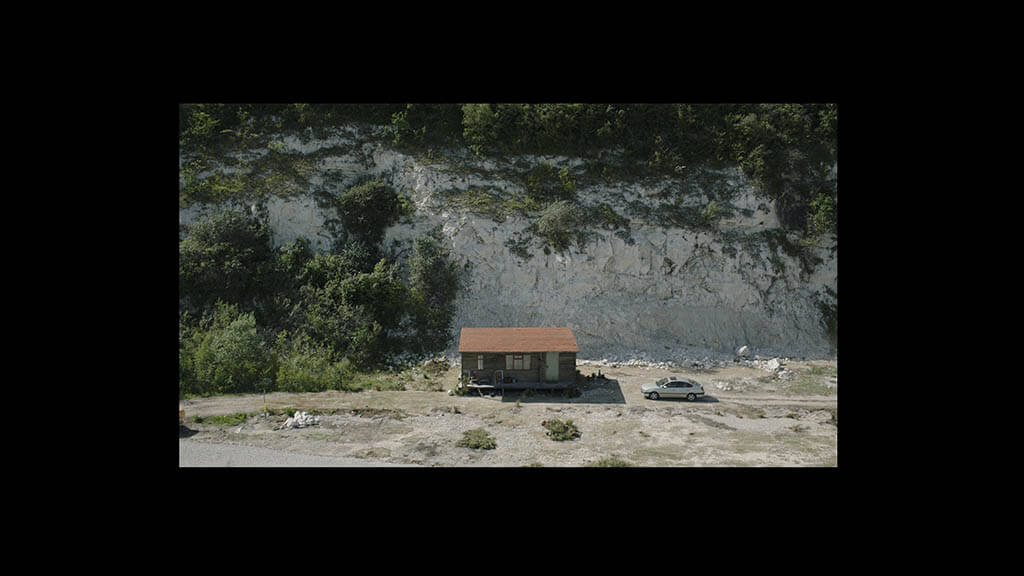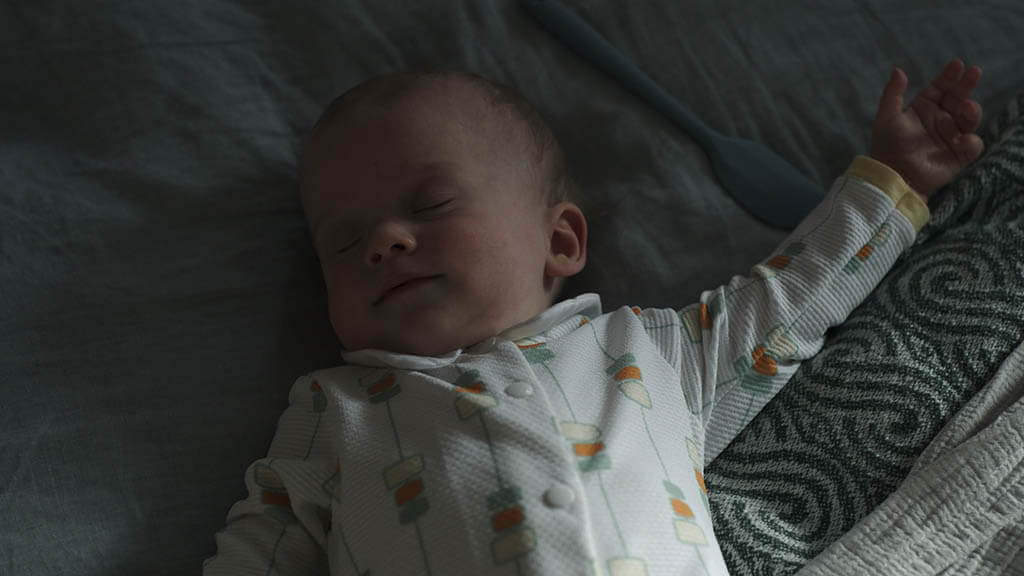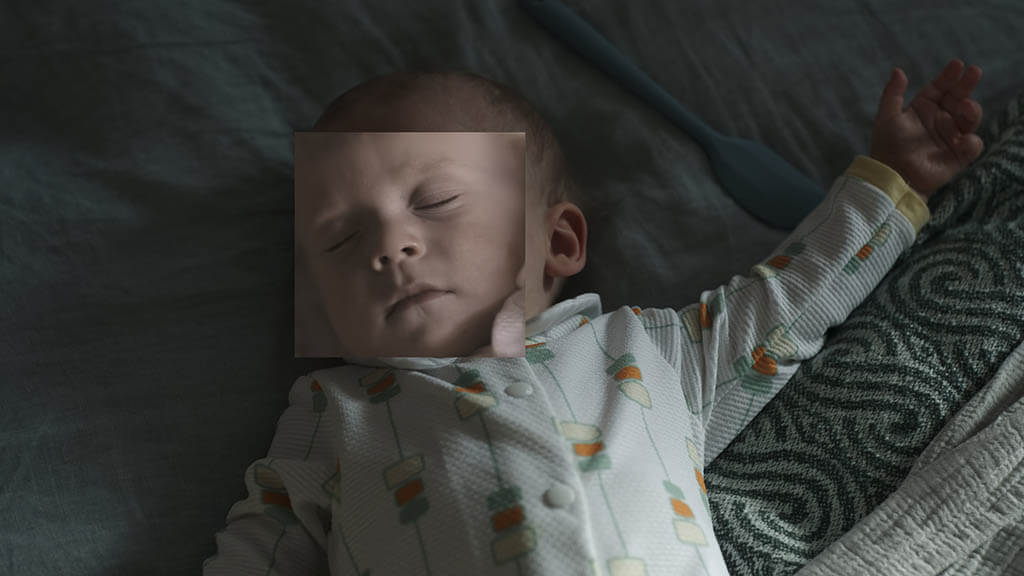By TREVOR HOGG
Images courtesy of Sky and HBO.
By TREVOR HOGG
Images courtesy of Sky and HBO.

Michelle de Swarte portrays Natasha who has a fateful encounter with a mysterious baby seeking to control her life.
Upon reading the synopsis for the HBO and Sky horror comedy The Baby, one gets a distinct impression that anxiety about motherhood drives the narrative created by Lucy Gayme and Siân Robins-Grace. The summary states, “Controlling, manipulative and with violent powers, the baby twists Natasha’s life into a horror show. Where does it come from? What does it want? And what lengths will Natasha have to go to in order to get her life back? She doesn’t want a baby. The baby wants her.” When this observation gets mentioned to VFX Producer Anne Akande and Visual Effects Supervisor Owen Braekke-Carroll both of them laugh in agreement. “It’s certainly a dissection of many angles of motherhood!” states Braekke-Carroll. “There is symbolism and scenes that absolutely tap into practical and real fears of breast feeding and abandonment. We were tasked with bringing some of the juicer parts of the script into the visual medium. It’s quite literal in many ways.”

Bobbi (Amber Grappy), Natasha (Michelle de Swarte) and Mrs. Eaves (Amira Ghazalla) stand in horror at the violent chaos that ensues in The Baby.
“We weren’t pushing [visual effects] beyond anything because the show was one that we knew early on was grounded in reality. The baby is a baby. There are a lot of misconceptions about what this baby is and what his agenda is. There are a few moments where we have some heightened reality and he is still a baby, but a bit different.”
—Anne Akande, VFX Producer
Gayme and Robins-Grace had a clear and descriptive vision of the reality and tone of the series. “Siân and Lucy were keen from the outset on getting a realistic and grounded tone throughout the series, and this influenced how we then approached the body of work,” remarks Akande. “We were involved early in the process to ensure that the shoot methodology would be effective and give visual effects enough material to pull off some of the more dramatic scenes. Beyond that giving the guidance, they were also collaborative, open and willing to take feedback on the best way forward via visual effects to hit each story point.” The visual effects work for the eight episodes consisted of just under 650 shots by Framestore, Jellyfish Pictures, Freefolk and Goldcrest. “We weren’t pushing it beyond anything because the show was one that we knew early on was grounded in reality,” notes Akande. “The baby is a baby. There are a lot of misconceptions about what this baby is and what his agenda is. There are a few moments where we have some heightened reality and he is still a baby, but a bit different.”


A key location is a seaside cottage at the base of a cliff, directly fronting the shoreline.


This beachside cliff was LiDAR scanned, recreated through DMP/CG, then combined with plate photography.
Nicole Kassell helmed the pilot, Faraz was responsible for three episodes, and Stacey Gregg and Ella Jones each directed two episodes. “It’s always interesting working with different directors across a series, and in this case they did all have different approaches to handling the visual effects,” states Akande. “Nicole Kassell had a lot of experience in visual effects and had a hands-on approach from storyboards, concept, previs through to execution. Others brought their comedy experience to help drive the storytelling beats, and there was also some experimentation using different shooting techniques and machinery on set. All of this brought an interesting mix that fused with the tone of the show, creating a unique place for The Baby in the comedy/horror genre.” Storyboarding and concept art were produced for all of the key creative beats.
“We definitely knew that we needed a digital asset. By casting twins, we were able to double our shooting hours. The babies absorbed the nature of the set quickly, and we saw them grow up over the course of six months of shooting with them. That left us with a strange, hybridized methodology over time, whether it be face replacements from plates with a CG body, a stand-in prosthetic baby with a head replacement being pushed around in a pram, or one digital arm, plate head and a prosthetic body. There was also an army of stand-in babies.”
—Owen Braekke-Carroll, Visual Effects Supervisor


The cottage and immediate gardens were built on the site of a small quarry which provided the immediate base of the cliff and surroundings.
“To compensate for [the unpredictability of the babies] on set, we ended up treating almost every frame with the baby cast in it as a potential visual effects shot. This included taking large volumes of data and notation for most scenes and essentially treating them as a CG creature in the scene.”
—Anne Akande, VFX Producer
“Concept art for key moments, such as our Demon Baby nightmare scene, was developed by the Framestore art department and was crucial in helping settle the creative vision as much as possible before shot execution,” remarks Braekke-Carroll. “From the storyboards, some key shots were turned into previs.” Scripts for the eight episodes were broken down to determine what shots required visual effects. “We worked closely with the art department throughout the shoot to help find the right combination of set, location and bluescreen,” explains Akande. “A key location in the script that we return to many times is a seaside cottage at the base of a cliff, directly fronting the shore line. Locations were unable to find a site that hit all the required points, so visual effects were tapped to make this work. The cottage and immediate gardens were built on the site of a small quarry, which gave us the immediate base of the cliff and surrounds. A secondary location along the site of a dramatic coastline in Newhaven [England] was the basis for the extension. This beachside cliff was LiDAR scanned, recreated through DMP/CG, then combined with plate photography to combine the two locations together.” Deaths are plentiful throughout the story, but the focus is on the aftermath rather than the actual act of violence. “There is an implied causal link between the baby and a death,” states Braekke-Carroll. “But he’s not necessary physically holding the knife.”



Due to the unpredictable nature of the babies on set, every shoot day could wildly deviate from the plan and the visual effects team would be required to help.
“The sheer nature of the amount of time that we were going to have a baby onscreen and on set meant that a lot of things we had planned for would sometimes go flawlessly without any help from us,” notes Braekke-Carroll. “On another occasion, the entire day might need to be completely changed and require our input for all sorts of reasons.” Identical twins were cast in the title role. “We definitely knew that we needed a digital asset,” remarks Akande. “By casting twins, we were able to double our shooting hours. The babies absorbed the nature of the set quickly, and we saw them grow up over the course of six months of shooting with them.” Digital doubles were avoided as much as possible. “That left us with a strange, hybridized methodology over time, whether it be face replacements from plates with a CG body, a stand-in prosthetic baby with a head replacement being pushed around in a pram, or one digital arm, plate head and a prosthetic body,” states Braekke-Carroll. “There was also an army of stand-in babies. When it comes to performance with our hero twins, that became a hybridized process where we used a combination of digital passes, keying tools, reprojections and face tracking from source plates. Then also leaning on machine learning additional 2D layering to change the performance.”
“It’s always interesting working with different directors across a series, and in this case they did all have different approaches to handling the visual effects. Nicole Kassell had a lot of experience in visual effects and had a hands-on approach from storyboards, concept, previs through to execution. Others brought their comedy experience to help drive the storytelling beats, and there was also some experimentation using different shooting techniques and machinery on set. All of this brought an interesting mix that fused with the tone of the show, creating a unique place for The Baby in the comedy/horror genre.”
—Anne Akande, VFX Producer
The eyes were difficult to get right. “The animation of the performance of the baby isn’t quite straightforward,” remarks Braekke-Carroll. “The eyes are quite loose and gaze differently. We took parts of plates for the area around the eyes for the micro-performance and combined that with CG or machine learning layers.” A wealth of material was gathered from reference photography. “We could be working on something in Episode 104 and there’s a performance that nails it in Episode 102,” states Akande. “Everybody on set was invested in getting us the material. It could be the first two seconds before the take, and that was needed for the face replacements. We also learned about which baby is good at being still or restless. The one thing that we tried to educate people on is that the babies are a member of the cast. If you replace a cast member with a stand-in for 30 shots, that becomes visual effects. Every time a baby was in a shot, the first port of call was our hero baby. The real performance will always be better than the alternative. CG was the last resort, and that was what we let the showrunners and executive producers know from the beginning.”
Face-generation camera setups were orchestrated that proved to be useful as animation reference and being utilized for machine learning. “Anytime we were using a digital baby performance and we would also be running a machine learning output as well,” explains Braekke-Carroll, “rather than treating that as a facial replacement solution we had it as an additional layer setup that could be incorporated partially or fully in with the other renders for the other parts. A lot of the shots that you will see won’t necessarily be a machine learning output, but there will be parts of the lips, eyes or cheek that will give it an extra degree of photographic verisimilitude that you get from that output.” One of the most difficult visual effects tasks was to have a baby falling asleep or sleeping. “We had to find a bunch of solutions and ended up shooting a lot of high-frame-rate plates of the baby and played them back at normal speed,” adds Braekke-Carroll. “We looked for a nice section where it felt like they were sleeping. A machine learning dataset was built just of the baby’s eyes. The high-frame-rate photography gave it a gentle effect, rather than trying to animate too much micro eye movement.”



The show had one primary asset, which was the baby digital double. The bulk of the baby work was handled by Framestore.



In some cases, shots were a combination of high-frame-rate plate photography, digital-double parts and a machine learning layer on top.
Point-of-view shots take place within the birth canal and womb. “We had a free remit to take B camera, get all of the jars of Vaseline, PCB tubing, probe lens, lights, blood, sputum and pus,” reveals Braekke-Carroll. “We took all of the bits and pieces and gelled them up. We got some nice closeup photography inspired by the scenes in The Tree of Life. I was pushing against building a CG interior because, tonally, I didn’t think that it fit the episode. From that photography, visual effects added a layer of fine particulate and endoscopic lensing. There is also the diffusion of the water and cloudiness. But the actual content of the walls was practical photography.”
“The one thing that we tried to educate people on is that the babies are a member of the cast. If you replace a cast member with a stand-in for 30 shots, that becomes visual effects. Every time a baby was in a shot, the first port of call was our hero baby. The real performance will always be better than the alternative. CG was the last resort, and that was what we let the showrunners and executive producers know from the beginning.”
—Owen Braekke-Carroll, Visual Effects Supervisor
The unpredictability of the on-set babies posed the biggest challenge across the series. “To compensate for this on set, we ended up treating almost every frame with the baby cast in it as a potential visual effects shot,” explains Akande. “This included taking large volumes of data and notation for most scenes and essentially treating them as a CG creature in the scene.” The best moment was literally saved for last. “We’re looking forward to the final sequence underwater,” states Braekke-Carroll. “It’s a beautiful and unexpected scene that wraps up the story and bookends the series nicely.”